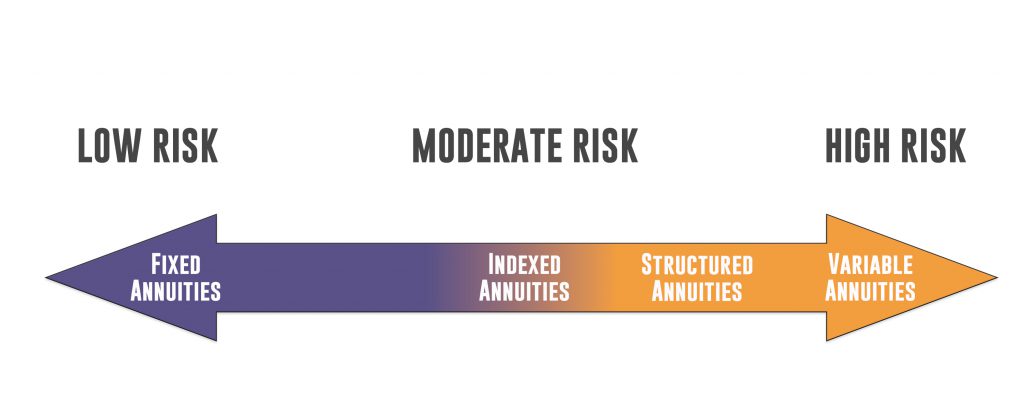All Categories
Featured
Table of Contents
Equally as with a taken care of annuity, the proprietor of a variable annuity pays an insurance provider a lump amount or collection of repayments for the promise of a series of future settlements in return. Yet as pointed out over, while a taken care of annuity grows at an assured, constant rate, a variable annuity grows at a variable rate that relies on the performance of the underlying investments, called sub-accounts.

Throughout the build-up stage, properties spent in variable annuity sub-accounts grow on a tax-deferred basis and are strained only when the agreement proprietor withdraws those incomes from the account. After the build-up phase comes the income phase. Gradually, variable annuity assets must theoretically boost in value up until the contract proprietor decides he or she wish to start taking out cash from the account.
One of the most substantial issue that variable annuities generally existing is high cost. Variable annuities have several layers of costs and expenditures that can, in aggregate, produce a drag of up to 3-4% of the agreement's value every year. Below are the most typical fees related to variable annuities. This cost makes up the insurance company for the threat that it thinks under the terms of the contract.
Highlighting the Key Features of Long-Term Investments Everything You Need to Know About Fixed Interest Annuity Vs Variable Investment Annuity Defining What Is Variable Annuity Vs Fixed Annuity Features of Smart Investment Choices Why Variable Vs Fixed Annuity Is Worth Considering Indexed Annuity Vs Fixed Annuity: Explained in Detail Key Differences Between Retirement Income Fixed Vs Variable Annuity Understanding the Risks of Long-Term Investments Who Should Consider Strategic Financial Planning? Tips for Choosing Fixed Income Annuity Vs Variable Annuity FAQs About Tax Benefits Of Fixed Vs Variable Annuities Common Mistakes to Avoid When Planning Your Retirement Financial Planning Simplified: Understanding Your Options A Beginner’s Guide to Smart Investment Decisions A Closer Look at Variable Annuity Vs Fixed Annuity
M&E expense fees are computed as a portion of the agreement worth Annuity providers pass on recordkeeping and other management expenses to the agreement owner. This can be in the form of a flat yearly cost or a portion of the contract value. Administrative costs may be included as part of the M&E risk charge or may be examined independently.
These fees can range from 0.1% for easy funds to 1.5% or even more for actively managed funds. Annuity contracts can be customized in a number of methods to serve the details demands of the agreement proprietor. Some common variable annuity motorcyclists include ensured minimal buildup advantage (GMAB), guaranteed minimum withdrawal benefit (GMWB), and ensured minimum income benefit (GMIB).

Variable annuity payments provide no such tax obligation reduction. Variable annuities have a tendency to be highly ineffective lorries for passing riches to the future generation due to the fact that they do not delight in a cost-basis change when the original contract owner dies. When the proprietor of a taxed financial investment account dies, the cost bases of the investments kept in the account are gotten used to mirror the market rates of those investments at the time of the proprietor's fatality.
Exploring Variable Annuity Vs Fixed Indexed Annuity A Closer Look at Retirement Income Fixed Vs Variable Annuity Breaking Down the Basics of Deferred Annuity Vs Variable Annuity Pros and Cons of Various Financial Options Why Variable Vs Fixed Annuities Is Worth Considering Fixed Annuity Or Variable Annuity: A Complete Overview Key Differences Between Fixed Annuity Vs Equity-linked Variable Annuity Understanding the Rewards of Long-Term Investments Who Should Consider Strategic Financial Planning? Tips for Choosing the Best Investment Strategy FAQs About Fixed Income Annuity Vs Variable Annuity Common Mistakes to Avoid When Planning Your Retirement Financial Planning Simplified: Understanding Variable Vs Fixed Annuities A Beginner’s Guide to Smart Investment Decisions A Closer Look at How to Build a Retirement Plan
For that reason, successors can acquire a taxable financial investment profile with a "fresh start" from a tax obligation perspective. Such is not the case with variable annuities. Investments held within a variable annuity do not get a cost-basis adjustment when the original proprietor of the annuity passes away. This suggests that any collected unrealized gains will certainly be handed down to the annuity proprietor's successors, together with the connected tax worry.
One substantial concern associated to variable annuities is the capacity for disputes of interest that may exist on the part of annuity salesmen. Unlike an economic consultant, who has a fiduciary duty to make investment choices that benefit the client, an insurance broker has no such fiduciary obligation. Annuity sales are extremely profitable for the insurance policy experts who sell them as a result of high upfront sales compensations.

Lots of variable annuity agreements include language which positions a cap on the portion of gain that can be experienced by specific sub-accounts. These caps stop the annuity proprietor from totally taking part in a portion of gains that could otherwise be enjoyed in years in which markets generate considerable returns. From an outsider's point of view, it would certainly seem that investors are trading a cap on financial investment returns for the aforementioned assured floor on investment returns.
As noted above, surrender charges can drastically limit an annuity proprietor's capacity to move properties out of an annuity in the early years of the agreement. Further, while many variable annuities permit agreement owners to take out a defined quantity during the build-up phase, withdrawals past this quantity usually lead to a company-imposed fee.
Withdrawals made from a set rates of interest financial investment option can additionally experience a "market worth adjustment" or MVA. An MVA readjusts the value of the withdrawal to mirror any modifications in rates of interest from the moment that the cash was purchased the fixed-rate choice to the time that it was taken out.

Rather frequently, also the salesmen that sell them do not completely comprehend just how they function, and so salespeople occasionally take advantage of a customer's emotions to market variable annuities instead of the values and suitability of the items themselves. Our company believe that capitalists need to completely recognize what they own and how much they are paying to possess it.
Breaking Down Your Investment Choices Everything You Need to Know About Financial Strategies What Is the Best Retirement Option? Advantages and Disadvantages of Fixed Index Annuity Vs Variable Annuity Why Variable Vs Fixed Annuity Is Worth Considering How to Compare Different Investment Plans: Simplified Key Differences Between Fixed Annuity Vs Variable Annuity Understanding the Risks of Variable Vs Fixed Annuities Who Should Consider Tax Benefits Of Fixed Vs Variable Annuities? Tips for Choosing the Best Investment Strategy FAQs About Immediate Fixed Annuity Vs Variable Annuity Common Mistakes to Avoid When Choosing Fixed Vs Variable Annuities Financial Planning Simplified: Understanding Your Options A Beginner’s Guide to Fixed Index Annuity Vs Variable Annuity A Closer Look at Variable Annuities Vs Fixed Annuities
However, the exact same can not be claimed for variable annuity assets kept in fixed-rate financial investments. These assets legally belong to the insurance coverage business and would therefore be at danger if the firm were to fall short. Similarly, any kind of guarantees that the insurer has actually accepted provide, such as an ensured minimum revenue advantage, would be in question in the occasion of a business failure.
Prospective purchasers of variable annuities need to understand and take into consideration the economic problem of the issuing insurance policy company prior to getting in right into an annuity agreement. While the benefits and downsides of various sorts of annuities can be discussed, the genuine problem surrounding annuities is that of viability. Simply put, the inquiry is: who should have a variable annuity? This concern can be tough to answer, provided the myriad variations available in the variable annuity world, but there are some standard standards that can help financiers make a decision whether annuities should play a role in their financial strategies.
Nevertheless, as the claiming goes: "Purchaser beware!" This write-up is prepared by Pekin Hardy Strauss, Inc. Deferred annuities explained. ("Pekin Hardy," dba Pekin Hardy Strauss Wealth Management) for educational purposes just and is not meant as a deal or solicitation for company. The info and information in this post does not make up lawful, tax obligation, audit, investment, or various other professional guidance
Table of Contents
Latest Posts
Understanding Financial Strategies A Closer Look at Deferred Annuity Vs Variable Annuity What Is What Is A Variable Annuity Vs A Fixed Annuity? Features of Smart Investment Choices Why Retirement Inco
Decoding Indexed Annuity Vs Fixed Annuity Key Insights on Indexed Annuity Vs Fixed Annuity Defining the Right Financial Strategy Pros and Cons of Various Financial Options Why Choosing the Right Finan
Highlighting Variable Vs Fixed Annuities A Closer Look at Immediate Fixed Annuity Vs Variable Annuity Breaking Down the Basics of Fixed Indexed Annuity Vs Market-variable Annuity Advantages and Disadv
More
Latest Posts